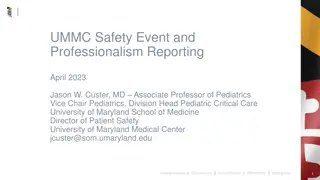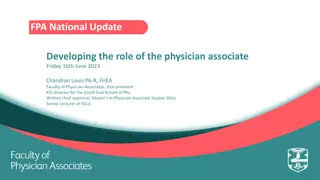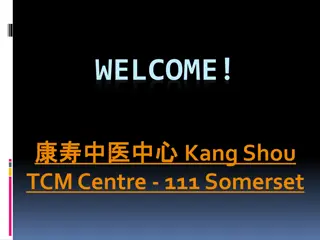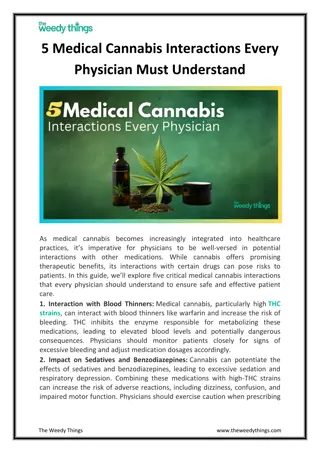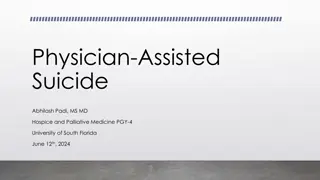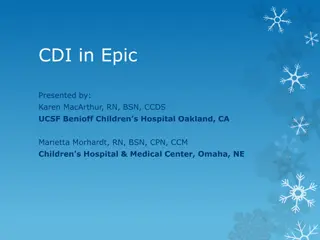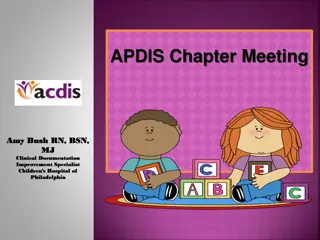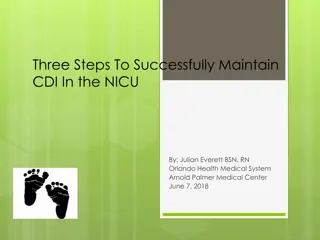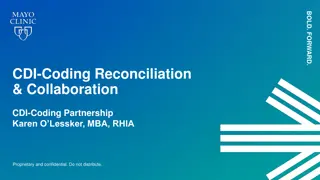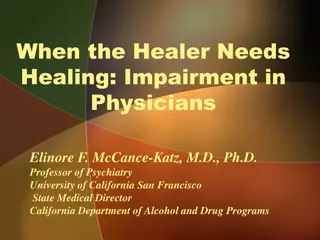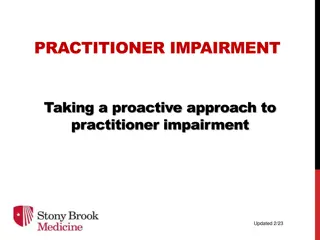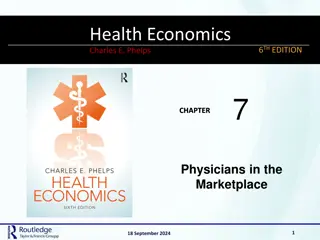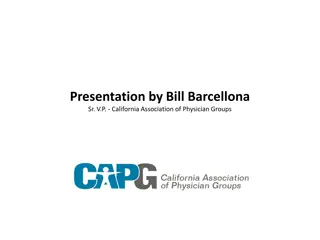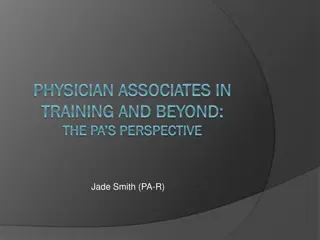Physician Engagement and CDI: Insights and Strategies
Successful Clinical Documentation Improvement (CDI) outcomes rely on physician engagement. Dr. Susan Kohl, a medical director at Baylor University Medical Center, shares perspectives, benefits, and barriers related to physician engagement with a CDI program. Learn about promoting engagement, recruiting physician champions, and ensuring follow-up for effective CDI implementation.
Download Presentation

Please find below an Image/Link to download the presentation.
The content on the website is provided AS IS for your information and personal use only. It may not be sold, licensed, or shared on other websites without obtaining consent from the author.If you encounter any issues during the download, it is possible that the publisher has removed the file from their server.
You are allowed to download the files provided on this website for personal or commercial use, subject to the condition that they are used lawfully. All files are the property of their respective owners.
The content on the website is provided AS IS for your information and personal use only. It may not be sold, licensed, or shared on other websites without obtaining consent from the author.
E N D
Presentation Transcript
Physician Engagement and CDI: A Physician Perspective Dr. Susan Kohl Medical Director CDI Baylor University Medical Center Dallas, Texas
Dr. Susan Kohl After growing up in Austin, Texas, Susan Kohl graduated with honors from the University of Texas at Austin. She graduated from medical school at the University of Texas Southwestern Medical School in 1991, followed by an internal medicine internship at the University of Colorado School of Medicine. She returned to Dallas to complete her internal medicine residency at UT Southwestern. Dr. Kohl has been an internal medicine hospitalist at Baylor University Medical Center since 1994, where she is the Associate Medical Director for one of the largest hospitalist groups in the country. Dr. Kohl has been the Medical Director for clinical documentation improvement, care coordination, and quality for BUMC since 2011, where she has worked closely with Clinical Documentation Improvement specialists to develop and present education for multiple members of the medical staff. She regularly updates and educates advanced practice providers, residents, attendings in various subspecialties of the importance of clinical documentation She was the recipient of the first ACDIS award for Excellence in Provider Engagement in 2016. She is married with a blended family of 7 children and enjoys hiking, running and competing in triathlons.
Objectives Identify benefits and barriers to physician engagement Review strategies to promote physician engagement with a Clinical Documentation Improvement (CDI) program Apply keys to identify and recruit a physician champion Define a process for physician follow-up 2
Physician Engagement Successful Clinical Documentation Improvement (CDI) outcomes cannot be fully realized without committed engagement from the physicians. It s all about the documentation and they are the authors. When strong team building takes place between hospital administrators, physicians, the CDI team and the coding department, physician engagement can be achieved. A close clinical working relationship, built on a culture of partnership and mutual respect must be developed and maintained 3
Benefits Accurate assignment of MS-DRG, severity of illness (SOI) and risk of mortality (ROM) levels Understanding as to how documentation affects expected length of stay (LOS) Supporting documentation for present on admission (POA) and patient safety indicators (PSI) Decreased queries Generate appropriate reimbursement and decrease denials 4
Benefits Mutual respect for individual roles in the medical record process Accurate physician and hospital profiles Understanding by physicians of the impact of their documentation on public reported data bases Complete and accurate medical record resulting in improved patient care, patient safety and data for research to benefit patients in years to come 5
Barriers American Hospital Association (AHA) CDI survey, Feb 2015 98.5% of programs believed their physicians could improve their documentation practices. When asked to list the top three barriers prohibiting physicians from engaging with CDI: 66.5% said a lack of understanding of the importance of documentation 47% said a lack of time 38% said a lack of interest 5% of programs said they had no barriers with physician involvement 89.2% of programs say they do not have a fulltime physician champion/advisor
Strategies to Promote Physician Engagement with CDI Make a compelling case using evidence based reasoning. Emphasize documentation impact on the flow of data from national to individual statistics. Get the competitive drive flowing: National trends of clinical documentation performance Facility s performance Physician department performance Individual physician performance Share specific data results with individual physicians and physician groups related to the impact on case mix index (CMI), severity of illness (SOI), risk of mortality (ROM) and length of stay (LOS) outcomes 7
Strategies to Promote Physician Engagement with CDI Demonstration of support for CDI objectives from upper management and physician leadership is vital Have hospital leadership identify the hospital s expectations by defining physician's responsibilities in obtaining CDI goals Get physicians involved early in the process Identify a physician champion and utilize skills Include CDI as part of the new physician staff orientation Focus education for the interns and residents Schedule time at service line section / staff meetings for new codes and requirements 8
Strategies to Promote Physician Engagement with CDI Provide education to guide physicians in required coding documentation AHA survey 2015: 84.3% of participants say real-time, patient specific conversations are the most effective education strategy to make physicians aware of how to improve documentation 9
Strategies to Promote Physician Engagement with CDI Utilize peer-to-peer physician champion Get a physician perspective on planned education before presenting Teach when they will listen Plan education around optimal learning venues Use service line specific examples Put it in writing Keep it short, specific, and data driven Develop news articles and, service line specific quick tips Email and post in physician dictation areas 10
Strategies to Promote Physician Engagement with CDI Promote an active discussion with physicians regarding identification of their challenges and issues regarding clinical documentation. Include them as part of the team Develop a collaborative atmosphere Ask what learning tools the physicians would find beneficial Have an understanding of the physician time required for compliance Process for answering a query in the EMR? Can it be simplified? Develop a favorite s list for frequent conditions 11
Strategies to Promote Physician Engagement with CDI Assign a physician and CDIS to the development team for EMR documentation improvements / issues Explain the deference between medical conditions and coding requirements 12
Physician Engagement / Impacting Quality In order to engage physicians, correlate how their clinical documentation provides an opportunity to: Demonstrate the quality of care that was provided for the patient Validate the care that was provided Show compliance with quality and safety guidelines 13
Physician Engagement / Impacting Quality Utilize data and the impact on facility and physician profiles: Value Based Purchasing (VBP) Patient Safety Indicators (PSI) Hospital Acquired Conditions (HAC) Readmission monitoring (CHF, MI) Surviving Sepsis Campaign 14
Physician Engagement / Impacting Accuracy Typographical Errors: Even with electronic medical records (EMR), spelling can still be an issue Example of Progress Note (PN) - misspelled words in red PN 11/4: S: Subjective wut svere sepis and malntiorn and dehydratio to the pint that renal faliure and gluseo ws elevat e beter this am therfor coniune therpay to replete elcectolytes and plan home miv and entyvio therapy PN 11/5: S: Subjective diarrhea and dehydration and renal failure appears to be due to a combination of pouchits and daivbertes and geting both under control feels better stool,l cultures negative ad insulin and start lomtil and plan iv fluids as an ouptient till entyvio kicks in 15
Case Study / Impacting Accuracy Initial SOI/ ROM Final ROM Case Scenario Documentation Opportunities 88 year old female presents with altered mental status / cough / SOB / fever PMH-HTN, DM, Breast Cancer SBP-70 , HR-130, RR-30, T-101 CXR indicates multi-lobar pneumonia WBC 18,000 / 30% bands Creatinine 1.9 (baseline 1.0) Lactate 6 ABG 7.28 / 28 / 58 on 50% face mask Unintentional wt. loss, poor po intake, nausea, diarrhea x 3 days, BMI 18.6, muscle wasting SOI 1 ROM 2 SOI 3 ROM 4 PDX sepsis Septic Shock Protein-Calorie Malnutrition Coding Septic Shock and Protein-Calorie Malnutrition raised the SOI/ROM to a 3/4 . Education Opportunity: Coders are not allowed to establish diagnoses based on vital signs and MD assessment; they must have the specific words. 16
Physician Engagement / Impacting Mortality Observed over expected mortality rate is an example of a risk adjusted measure. The lower the score the better: Observed deaths: the number of patients who died at the hospital in a specific time frame Expected deaths: the sum of predicted risk of death; average expected number of deaths based upon diagnosed conditions, age, gender, etc. within the same timeframe O/E ratio: Observed deaths divided by Expected deaths 17
Physician Engagement / Observed : Expected Ratio Example: (The worked example below uses 30 day mortality) 10 patients admitted with MI Observed inpatient deaths = 2 Observed deaths within 30 days of admission for MI = 1 1 patient died within 30 days ( patient 5 ) / ( Patient 6 died 43 days after admission) Expected deaths within 30 days of MI admission = 3 O:E ratio = 1 18
Physician Engagement / Mortality Documentation Some patients are admitted for end of life care (metastatic cancer, devastating stroke) and placed on a comfort plan of care Often documentation in these cases is less intensive The chart may not give a complete and accurate picture of the patient s dying process and can code to a low severity of illness, risk of mortality This is especially concerning on short length of stay cases. The data will not reflect: quality of care given by the staff or utilization of resources facility and physician profiles can be negatively impacted 19
Physician Engagement / Mortality Documentation With education and understanding of predicted mortality measures, engaged physicians can provide the documentation that reflects the impending demise of the patient Examples would be documentation of some of accompanying conditions: shock respiratory failure coma severe protein-calorie malnutrition 20
Case Study / Impacting Mortality Initial SOI ROM SOI 2 ROM 2 Final SOI ROM Case Scenario Documentation Opportunities 64 y/o admitted with refractory leukemia, adm for hospice unresponsive, responding only to deep pain stimuli shallow respirations, cheyne-stokes sats-88% on 5L nc cachexic, BMI 18, poor po intake, Low Na, Low K, PMH: HTN, dislipidemia malnutrition raised the SOI/ROM to a 4/4 . Educational Opportunity: Coders are not allowed to interpret low or high designation of electrolytes. Please be mindful to document specific organ failure on patients who are actively dying. SOI 4 ROM 4 Encephalopathy Respiratory failure Severe Protein-Calorie Malnutrition Hyponatremia, Hypokalemia Coding encephalopathy , respiratory failure and severe protein-calorie 21 21
Keys to Identify and Recruit a Physician Champion The physician champion / advisor role is vital for educating physicians regarding: Importance of compliance to the various regulations that impact CDI As a mediator in times when there are conflicts among medical staff or with other departments The person considered for the role requires: Good communication skills Recognition by the medical staff as expert in the individual s field 22
Keys to Identify and Recruit a Physician Champion Possible recruits are physicians involved in patient quality and safety, utilization review, case management, denials / appeals and compliance Who is interested and asking questions? Chief of Staff for a service line? Who is doing it right ? Does not have to be one person Go armed with data! (Justify the need) Don t forget to lobby for in-depth CDI education for the role 23
Process for Physician Follow-Up An identified policy / process for physician follow-up provides the opportunity for intervention when dealing with physician compliance issues and establishes a clear roadmap for role responsibilities and penalty for non-compliance Must involve support from upper management, chiefs of staff and department directors Contain clear policies for documentation non-compliance, role expectations and time line (example: time based suspension) Employ respect and good manners in all communications. Individual communication with a physician should take place initially before involving another level of intervention 24
Process for Physician Follow-Up Example Process: Develop policy guidelines with support from upper management, physician champion, compliance department and CDI management Educate physicians on the policy, impact of non-compliance on patient, facility and physician profile outcomes State date of implementation 25
Process for Physician Follow-Up Example Process: Level 1: CDI: Notify physician of pending query or documentation issue in violation of policy. Provide physician with potential impact of documentation or query response (face to face, email, phone call) and document in the record Level 2: CDI: Notify your manager and physician champion or chief of staff regarding issue for additional intervention Level 3: HIM Director or designated person: Invoke penalty and notify physician (i.e. suspension of privileges until compliance obtained) Maintain open communication and follow-up with physician 26
Summary To bring about meaningful change in physician behavior and outlook, physicians must understand the impact of their documentation on the patient record and public data as well as see the benefit of a close clinical working relationship Physician engagement is one of the most important components to a successful CDI program. With the right strategies, education, and team work, great success can be achieved 27
Thank You 28
Resources ACDIS, CDI Week, September 22, 2017, Q&A CDI Week, Physician Engagement by Kristie Perry, R, MHSA, CCDS, CCS ICD10 Monitor: Aug 8. 2017: Does a CDI Program Improve Physician Engagement? by Glenn Krauss, RHIA, BBA,CCS, CCS-P, CCDS, C-CDI, PCS, FCS, C-CDAM Journal of AHIMA, July 2017: AHIMA Practice Brief: Impact of Physician Engagement Hospitals & Health Networks: Aug 13 2015. Getting Physicians Behind a Clinical Documentation Initiative by Todd J. Kisiak Becker s Hospital Review: May 13, 2015. Integration & Physician Issues: 5 Steps for Engaging Physicians in Clinical Documentation Improvement Programs by Tamara Rosin American Hospital Association (AHA) CDI survey, Feb 2015 29


